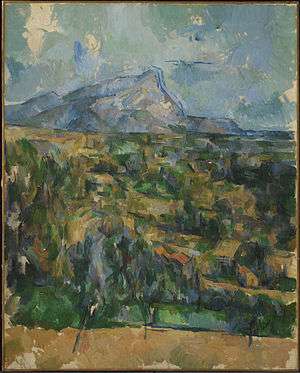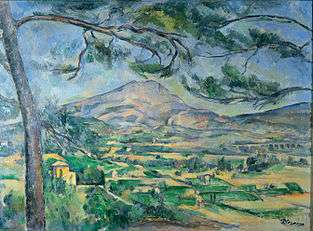Mont Sainte-Victoire (Cézanne)
 | |
| Artist | Paul Cézanne |
|---|---|
| Year | 1904-06 |
| Medium | Oil on canvas |
| Location | Princeton University Art Museum |
Mont Sainte-Victoire is a series of oil paintings by the French artist Paul Cézanne.
Description
The Montagne Sainte-Victoire is a mountain in southern France, overlooking Aix-en-Provence. It became the subject of a number of Cézanne's paintings.
In these paintings, Cézanne often sketched the railway bridge on the Aix-Marseille line at the Arc River Valley in the center on the right side of the picture. Especially, in Mont Sainte-Victoire and the Viaduct of the Arc River Valley (1885–1887), he depicted a moving train on this bridge.
Only half a year after the opening of the Aix-Marseille line on October 15, 1877, in a letter to Émile Zola dated April 14, 1878, Cézanne praised the Mont Sainte-Victoire, which he viewed from the train while passing through the railway bridge at Arc River Valley, as a “beau motif (beautiful motif)”,[1] and, in about that same year, he began the series wherein he topicalized this mountain.[2]
These paintings belong to Post-Impressionism. Cézanne is skilled at analysis: he uses geometry to describe nature, and uses different colours to represent the depth of objects.
Gallery


 Montagne Sainte-Victoire, 1890, Scottish National Gallery
Montagne Sainte-Victoire, 1890, Scottish National Gallery Mont Sainte-Victoire and Château Noir, 1904–06, Bridgestone Museum of Art
Mont Sainte-Victoire and Château Noir, 1904–06, Bridgestone Museum of Art
References
- ↑ Paul Cézanne, Correspondance, recueillie, annotée et préfacée par John Rewald, nouvelle édition révisée et augmentée, Paris: Bernard Grasset, 1978, p. 165.
- ↑ "Tomoki Akimaru, "Cézanne and the Steam Railway (1)~(7)", Japan, 2012". Tomokiakimaru.web.fc2.com. Retrieved 2014-03-22.
External links
| Wikimedia Commons has media related to Montagne Sainte-Victoire by Paul Cézanne. |
- WebMuseum: Cézanne, Paul: The Mont Sainte-Victoire and Bibemus saga
- Mont Sainte-Victoire (1902)
- Mont Sainte-Victoire (1902-1904) (Archived 2009-11-01)